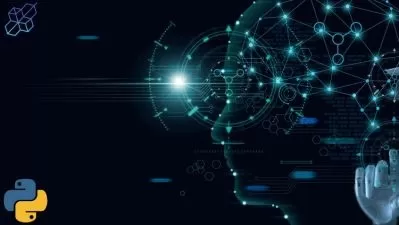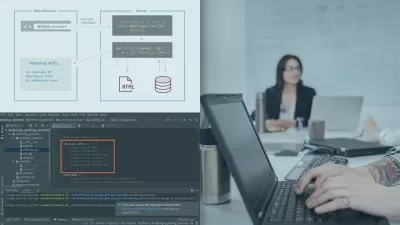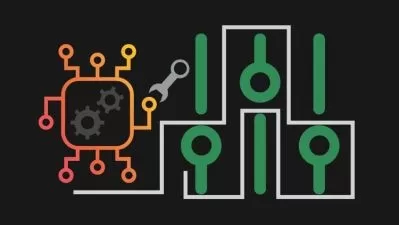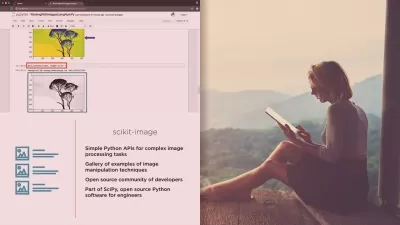01.01-introduction to course.mp4
05:00
01.02-why machine learning.mp4
10:21
01.03-why support vector machine.mp4
06:18
01.04-course overview.mp4
05:57
02.01-introduction to machine learning learning process and supervised learning.mp4
17:00
02.02-unsupervised learning and reinforcement learning.mp4
08:54
02.03-history and future of machine learning.mp4
14:46
02.04-dataset label and features.mp4
15:34
02.05-training data testing data and outliers.mp4
06:46
02.06-model.mp4
07:28
02.07-model (difference between classification and regression).mp4
07:23
02.08-model (function parameters hyperparameters).mp4
08:32
02.09-training a model cost error loss risk and accuracy.mp4
11:20
02.10-optimization.mp4
07:46
02.11-overfitting underfitting just right optimum (part 1).mp4
05:25
02.12-overfitting underfitting just right optimum (part 2).mp4
02:30
02.13-validation and cross validation generalization data snooping validation set.mp4
11:07
02.14-probability distributions and curse of dimensionality.mp4
08:13
02.15-small sample size problems one shot learning.mp4
06:06
02.16-importance of data in machine learning data encoding and preprocessing.mp4
13:56
02.17-general flow of a typical machine learning project.mp4
06:35
03.01-introduction to python.mp4
03:42
03.02-introduction to ide hello world.mp4
08:02
03.03-introduction to data type numbers.mp4
06:19
03.04-variable and operators (numbers).mp4
08:11
03.05-variables and operators (rational operators and functions).mp4
11:49
03.06-variables and operators (string).mp4
08:12
03.07-variables and operators (string and print statement).mp4
07:30
03.08-lists (indexing slicing built-in lists in functions).mp4
21:22
03.09-lists (copying a list).mp4
04:02
03.10-tuples (indexing slicing built-in tuple functions).mp4
03:51
03.11-set (initialize built-in set functions).mp4
03:56
03.12-dictionary.mp4
04:36
03.13-logical operator decision making for loops while loops functions.mp4
07:20
03.14-logical operator decision making for loops while loops list comprehension.mp4
14:33
03.15-functions.mp4
09:53
03.16-calculator project.mp4
19:03
04.01-introduction to svm.mp4
04:46
04.02-linear discriminants.mp4
08:15
04.03-linear discriminants higher spaces.mp4
08:22
04.04-linear discriminants decision boundary.mp4
09:35
04.05-generalized linear model.mp4
10:20
04.06-feature transformation.mp4
11:34
04.07-max margin linear discriminant.mp4
10:19
04.08-hard margin versus soft margin.mp4
09:11
04.09-confidence.mp4
09:25
04.10-multiclass extension.mp4
13:45
04.11-svm versus logistic regression sparsity.mp4
12:49
04.12-svm optimization.mp4
11:53
04.13-svm langrangian dual.mp4
12:12
04.14-kernels.mp4
07:50
04.15-python packages and the titanic dataset.mp4
07:00
04.16-using numpy pandas and matplotlib (part 1).mp4
08:10
04.17-using numpy pandas and matplotlib (part 2).mp4
06:26
04.18-using numpy pandas and matplotlib (part 3).mp4
11:35
04.19-using numpy pandas and matplotlib (part 4).mp4
13:45
04.20-using numpy pandas and matplotlib (part 5).mp4
11:29
04.21-using numpy pandas and matplotlib (part 6).mp4
10:13
04.22-dataset preprocessing.mp4
14:47
04.23-svm with sklearn.mp4
15:44
04.24-svm without sklearn (part 1).mp4
04:38
04.25-svm without sklearn (part 2).mp4
11:54
05.01-optional svm optimization (part 1).mp4
05:28
05.02-optional svm optimization (part 2).mp4
12:18
05.03-optional svm optimization (part 3).mp4
12:02
05.04-optional svm optimization (part 4).mp4
19:47
05.05-optional svm optimization (part 5).mp4
20:56
05.06-optional svm optimization (part 6).mp4
14:02
9781801071833 Code.zip
















